Published monthly for CC employees by Clinical Center Communications
September 1998
CC and NRH join forces
Gallin at NMA
CC smoking
Students exceed
CC summer students
Dr. Lewis retires
Medicine for the Public
Lectures
Flu shots
Facts on influenza
News briefs
|
|
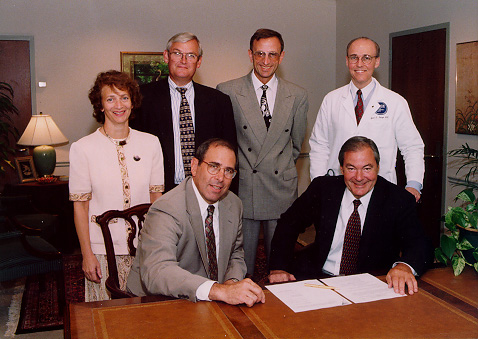
CC and National
Rehabilitation Leaders
CC and NRH leaders at the cooperative agreement signing ceremony. Shown
are (standing left to right) Dr. Lynn Gerber, chief of the Rehabilitation
Medicine Department, Dr. David Henderson, deputy director for clinical care,
Dr. Gerben DeJong, NRH Research Center director, and Dr. John Toerge, NRH
medical director and senior vice president. Seated are CC Director Dr. John
Gallin and Edward Eckenhoff, NRH president and CEO.
CC and National Rehabilitation Hospital join forces
The CC and the National Rehabilitation Hospital (NRH) have joined efforts
to provide assistance for individuals with physical disabilities caused
by illness and injury. The collaboration allows the institutions to work
together in areas of mutual interest while sharing their expertise in different
clinical problems.
"This alliance offers the best of both worlds," said Dr. John
Gallin, CC director. "It will enhance care for patients at both institutions
while enriching the learning environment for staff physicians in both settings."
Under the agreement, staff physicians at the CC and the NRH will serve
as preceptors for physicians in advanced training as fellows and residents.
The agreement also provides an umbrella for encouraging and expanding cooperative
efforts in clinical research, referral of patients, and consultation in
patient care.
The NRH, located in Washington, D.C., offers comprehensive rehabilitation
for individuals with significant loss of function, usually as a result of
traumatic injury or stroke, while the CC provides rehabilitation for patients
who have lost function through disease, often rare neurologic conditions
or cancer. This agreement grants NRH physicians a chance to work with conditions
that are less common in the general population, while offering NIH researchers
experience with more common functional problems.
index |
CC Director Dr. John Gallin among NIH representatives
at the National Medical Association conference
"The practicing physician plays an enormous role in delivering
clinical research to patients," said CC Director Dr. John Gallin,
one of several presenters at a symposium held during the National Medical
Association (NMA) Annual Convention and Scientific Assembly early last
month in New Orleans, Louisiana.
The Edward C. Mazique Symposium, titled "Science, Service and Business
of Practice-Based Research: A Mecca for African-American Physicians and
Patients?" also included presentations by NIH's Dr. Vivian Pinn, director
of the Office of Research on Women's Health (ORWH), and Dr. John Ruffin,
associate director of the Office of Research on Minority Health (ORMH).
Additional panel members were Rep. Dr. Donna Christian-Green (D-Virgin
Islands), and Dr. Robert Harrison III, professor of medicine at the University
of Rochester School of Medicine and Dentistry. Dr. David Satcher, U.S.
Surgeon General, delivered opening remarks.
Dr. Gallin told an audience of NMA-member physicians that clinical research
has in the past not been an area of formal training in many medical schools,
but as the number of clinical trials increases, practicing physicians are
becoming a critical part of the research process. As a result, training
for all medical staff is important.
"Should clinical research training be included in the medical school
curriculum, either as a mandatory or elective course?" he asked. "My
argument is that it should."
During his presentation, Dr. Gallin also discussed some of the obstacles
to physicians' involvement in clinical research, including medical school
debt, managed care, mistrust by patients, inadequately informed public,
and lack of training for health professionals.
According to Dr. Gallin, the Clinical Center and NIH are currently working
to find solutions for some of those barriers, including providing medical
school graduates pursuing a career in clinical research with $20,000 per
year, tax free, through a loan repayment program; the use of telemedicine
to link rural clinics to NIH physicians; increased access to health and
protocol information on the internet; and improved safeguards and heightened
awareness of the protocol process. Another area of interest is expanding
the 75 general clinical research centers across the country, which currently
support 8,000 protocols and are coordinated by the NIH. "My dream
is that we link all these centers together and we link anyone anywhere
who wants to do clinical research in the world together to create a virtual
clinical research center," he said.
In a presentation titled, "Why Women and Minorities Should Care
About Biomedical Research," Dr. Pinn discussed some of the disparities
in health among minority populations, and explained why having diverse
groups represented in all aspects of clinical research is important.
"To overcome disparities we need the scientific data from clinical
research to help us effect change in health care and health care policy,"
she said. She further stressed the need for minority involvement in clinical
research, not just as volunteers, but also as investigators and policy
makers. Dr. Pinn said that one way to increase the number of minorities
in clinical trials is to give them more opportunities to participate, and
she emphasized the role of the CC in that endeavor. "We are seeing
a great outreach effort, one that I applaud, of the Clinical Center, to
try to make sure that we have inclusion of minority populations of the
studies that are conducted there."
Dr. John Ruffin discussed the role that the ORMH and the ORWH play in
obtaining information from the public and bringing it back to the NIH.
"Our offices were given a challenge," he said. "We have
to quickly identify what it is that we should be doing that we are not
doing." According to Dr. Ruffin, approximately 60% of the budgets
of these offices comes from recommendations that they receive from the
public. "What we do is take those recommendations to people who make
a difference, to see if they can be converted into good science,"
he said. He further challenged attendees to use NIH as a resource and encouraged
them to make their needs known. "Your recommendations should continue
to come to the NIH, " he said. (by LaTonya Kittles)
index
|
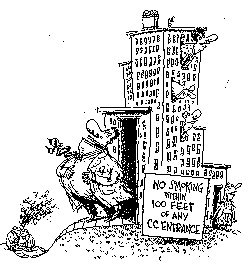
Help Make Breathing Easier at the Clinical Center--Smoking is prohibited
within 100 feet of all entrances and in "Smoke-Free Zones."
CC'ers reminded of smoking policy
Fumes from tobacco smoke are known to affect smokers and non-smokers
alike. To help curb the associated risk of exposure to environmental tobacco
smoke, the NIH instituted a ban on the use of lighted tobacco products in
various locations, including NIH buildings both on and off campus, in government-owned
vehicles, near entrances and exits, and within designated "Smoke-Free
Zones."
Unique to the CC is a policy developed in accordance with the standards
ofthe Joint Commission on Accreditation of Healthcare Organizations, which
was approved by the Medical Executive Committee in 1992, and takes into
account not only the employees of the CC, but also its patients and visitors.
Here, the health risks of smoking are coupled with another known risk, deaths
due to fire. Findings reported by the National Fire Protection Association
showed that 75 percent of fire fatalities in health-care institutions occur
among patients using smoking materials.
Therefore, at the CC, smoking has been banned in all patient-care
units, and throughout the building, including all stairwells and parking
garages. Smoking is also prohibited within 100 feet of all entrances and
in "Smoke-Free Zones."
Employees who wish to stop smoking can call the NIH Employee Assistance
Program for information and referral at 6-3164.
index |
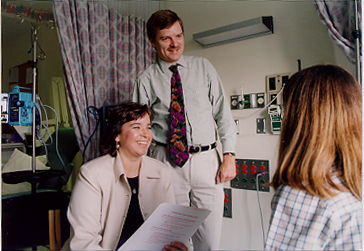
Summer Student Program
Maia Gemignani worked this summer in the Social Work Department as an
intern. Shown with her supervisor, CC Social Worker Fred Boykin, both spoke
highly of the summer student program as an excellent opportunity to gain
experience in the clinical setting.
Program for students meets, exceeds expectations
The summer's end brought a close to the 1998 CC summer program for students.
This unique program has given 73 college and high school students an opportunity
to expand their horizons and gain experience in the workplace.
"I think it's an outstanding program," said Carl Lucas, EEO
chief and coordinator of the summer student program. "I feel that it
gives aspiring scientists and doctors a chance to explore potential opportunities
at the NIH."
In the program, students can work in a science-based, allied health,
or administrative position. This enables students with a variety of interests
to explore options at the CC.
"Having the youth within the CC ask challenging questions raises
the awareness of those of us who have been at NIH for a long time,"
said Lucas. "We are able to exchange something with these students,
as they help us work in a direction that we may not have thought about."
Jay Wang, a second-year premed chemistry major at the University of California,
Berkeley, spent this summer working with the Clinical Pathology Department.
It's his third summer here at the CC.
"My first summer I started working as a volunteer for Dr. Csako,"
said Wang. "I guess I worked pretty hard because he wanted to have
me back the following years."
Wang's supervisor, Dr. Gyorgy Csako, is pleased with the program and
the work of his interns. This summer he worked with two other students in
addition to Wang.
"Our department is very happy with the program," said Dr. Csako,
senior staff scientist of chemistry in the Clinical Pathology Department.
"Jay is one of the most successful students we've worked with. He has
extremely good skills and we are happy to have him on board."
Another member of the summer program, Maia Gemignani, a graduate student
at Virginia Commonwealth University, also enjoyed her summer in the Social
Work Department.
"As I expected, I had a very rich experience at the NIH," said
Gemignani. "I became familiar with many different illnesses and was
able to interact with many different disciplines regarding patient care.
I was also fortunate to talk to many patients and gain insight into what
their experiences with chronic illness mean to them."
She is pursing her master's degree in social work and will begin her
final year of study this fall.
"Maia has been an excellent intern this summer," said her supervisor,
CC Social Worker Fred Boykin. "She has brought a wealth of research
experience into her position and assisted in our research efforts. She has
also gained experience both in the clinical and research arenas."
According to those involved, the summer student program has once again
proved to be a valuable program within the Clinical Center for both the
students and those who work with them. (by Bonnie Flock)
index |
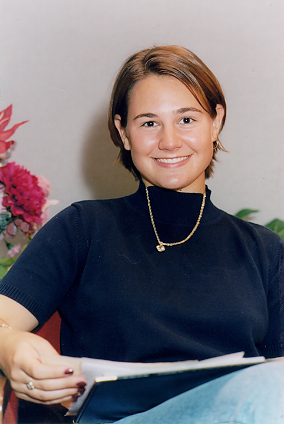
Summer Intern
CC Communications summer intern Bonnie Flock is entering her junior year
at Ithaca College in upstate New York.
A Summer at the CC: Press, articles, action
"NBC is coming," said my supervisor with excitement, yet hesitation.
Then in that moment, the frenzy set in. The NIH police must be notified,
as well as the parking office. A decision must be made as to who will accompany
the crew. They must then grab some patient consent forms and head out.
. . but wait . . . "Never mind, they're not coming," sigh. The
crew from NBC got a last minute call and had to go on another assignment.
After all, nothing in the communications field is really definite-until
it happens.
This is just one of the elements I have come to know and experience
this summer as an intern in the Office of Clinical Center Communications.
Actually, I have learned quite a few lessons at the CC. The combination
of communications and the clinical setting has not only taught me about
my field, but also about life.
Certainly the professional experience I have gained this summer will
be invaluable to my future. Learning the basics about press calls, HTML
and web design, and writing for the CC News have all given me the opportunity
to learn more about various aspects of the communications field.
It is, perhaps, the lessons I have learned from the experiences of others
that may prove to be the greatest experience of all. I have had the privilege
of interviewing some amazing people that have truly had some important
stories to share.
One of my first assignments of the summer was a piece on T'ai Chi at
the CC. After speaking to the recreation therapy department and Dr. Ge,
I was invited to participate in one of the T'ai Chi classes. Participating
alongside the patients added a whole new perspective to what T'ai Chi has
to offer. Talking to the patients involved afterwards was a really moving
experience. The strength these people have in the face of adversity and
illness is such an inspiration.
I also had the opportunity to meet Barbara Saltzman and listen to her
reading of her late son's book, "The Jester Has Lost His Jingle."
She lost her 22-year-old son to Hodgkin's disease in 1990. His dream was
to have this book published, and she made that dream a reality. Saltzman
embodies strength and is proof that anything is possible with determination
and will. She brings the book alive by being an example that laughter and
happiness are inside all of us, even when times are the hardest.
So to capture the essence of my summer at the CC, I would have to say
it has been an eye-opener. I was exposed to situations and circumstances
that I hadn't known before. My expectation for any job is that it expands
my horizons in some way; the CC did just that. (by Bonnie Flock) index
|

Dr. Lewis retires
Dr. Thomas Lewis recently retired after 27 years at the CC. He is shown
here recycling some files that have accumulated since his arrival in 1971.
Associate director for information systems retires
Dr. Thomas Lewis, associate director for information systems, recently
retired after 27 years at the Clinical Center.
Dr. Lewis has been associate director since 1982, and is best known for
his work with developing the medical information system (MIS), which houses
patients' clinical information. He has also played a large role in upgrading
and enhancing the MIS, including reassessing existing systems, developing
strategies for appropriate enhancements, integrating new technologies, and
evaluating cost-effective alternatives for meeting clinical, research, and
management information needs. His recent technical work has been directed
at providing more resources to medical staff by integrating patient care
systems with large research data archives, and enhancing the systems' data
retrieval, analysis, and display capabilities.
He received his doctor of medicine in 1970 from Yale Medical School and
interned in medicine and pediatrics at New Haven Hospital in Connecticut.
He served as a clinical associate in 1971 and in 1974 became a resident
in the Clinical Pathology Department, where he participated in epidemiological
studies on hepatitis and vitamin C. He was also responsible for performing
and supervising computer programming and statistics in the department. He
served that department as chief of both the laboratory computer service
and the office of clinical and management systems until 1982.
While with the Clinical Pathology Department, he focused on using computers
to help the hospital work better, thus the birth of the MIS. "Initially
we were tasked with replacing an old computer system and it led to the development
of a system to retrieve lab data," he said. "The MIS process was
extremely exciting because we were able to talk to clinical directors and
medical staff to learn what they would like to see in a system."
Dr. Lewis speaks very highly of his time here at the CC and most importantly
being able to work with some wonderful people. "One of the most satisfying
things for me here was to be able to help prepare junior staff, including
Stay-in-School staff and Stride Program participants, and watch them grow,"
he said.
During his retirement Dr. Lewis plans to take several months to make
plans for the future and is considering consulting with several new businesses
on health care technology. He plans to continue working with the Information
Systems Department to help upgrade the MIS.
In regard to his departure, he said, "It's difficult to leave, but
it's time to try some new challenges." (by LaTonya Kittles)
index |
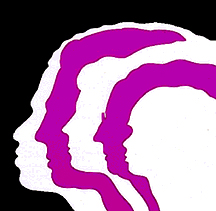
Medicine for the Public lectures begin Oct.
6
Every day, scientific discoveries bring us closer to cures and therapies
for complex and intricate diseases. As these discoveries are made, the
public continues to crave accurate and useful health information, including
new therapies, diagnostic procedures, and research.
To that end, the 1998
Medicine for the Public lecture series, sponsored by the Clinical Center,
will help to satisfy this hunger for information on the latest developments
in medicine.
This year's lectures, which are free and open to the public, will be
held at 7 p.m. on Tuesdays in Masur Auditorium. Featured speakers include
physician-scientists working at the forefront of medical research at the
NIH. The sessions include:
Oct. 6, Imaging My Brain-Dr. R. Nick Bryan, director, CC Diagnostic
Radiology Department, and associate director for Radiologic Imaging, will
take you on a virtual tour of his own brain, highlighting how the latest
imaging technology makes it possible to view internal body structures in
great detail. He will also show how these techniques have added to our
knowledge of the aging normal brain and its diseases.
Oct. 13, Environmental Risks for Disease-Dr. Kenneth Olden, NIEHS
director, discusses reducing the burden of human illness and dysfunction
from environmental causes. He will discuss the relationship between three
interactive elements of human health and human disease: environmental factors,
individual susceptibility, and age.
Oct. 20, Medical Ethics in American Health Care-CC Bioethics Chief
Dr. Ezekiel Emanuel will touch upon important ethical issues facing
our health-care system, such as informed consent, euthanasia, and the patient-physician
relationship.
Oct. 27, Childhood Hyperactivity: New Research-Dr. Judith Rapoport,
chief of the Child Psychiatry Branch of the National Institute of Mental
Health, will present what researchers have learned in the last decade about
childhood hyperactivity, including identification of the problem and current
treatment options.
Nov. 10, Kidney Cancer: Understanding How Genes Impact Cancer-Dr.
Marston Linehan, head of the urologic oncology section of the National
Cancer Institute's Surgery Branch, will explore the genetic basis of kidney
cancer and what that implies for other forms of cancer.
Nov. 17, A Smile for a Lifetime-Dr. Harold Slavkin, director
of the National Institute of Dental Research will examine today's research
and tomorrow's possibilities in the field of dental implantology.
Sign language interpreters will be provided. For other reasonable accommodations,
or more information on specific topics or speakers, call 6-2563.
index
|
It's that time again, OMS offers flu shots to employees
Test your knowledge of the flu by answering true or false to the following
statements.
1. True or False. Flu can be debilitating, even for healthy people.
2. True or False. People infected with the flu are contagious before
their own flu symptoms develop.
3. True or False. Flu is very infectious, and can be passed from person-to-person
through casual contact.
All of the above statements are true. In fact, the flu can debilitate
healthy people and is particularly serious if transmitted to the elderly
or to patients with certain chronic medical conditions. Also, people are
usually iinfectious up to two days before fevers, coughs, and aches even
begin. And finally, the flu (unlike some other types of illnesses) can be
passed through casual contact and can also be passed along during direct
patient care. Therefore, it is now part of good medical practice for health
care workers to be vaccinated against the flu. Every year, health-care workers
nationwide have benefited from receiving these vaccinations, protecting
themselves, and their patients, from serious illness.
All CC health-care workers are recommended to receive an annual vaccination
to protect against the flu. So again this year, flu vaccinations will be
offered through Occupational Medical Services (OMS).
This year's vaccine protects against both influenza A and B. CC staff
can "Foil the Flu" by receiving a shot during many convenient
times and at numerous locations throughout the hospital. Special "early-bird"
health-care worker vaccinations will take place on Oct. 6 through 9. Look
for schedules on patient-care units and clinics. Beginning Oct. 13, the
OMS (room 6C306) will offer walk-in times during the day. Because evening
clinics will not be offered this year, afternoon clinic times are extended.
For more detailed information about the flu vaccine, including off-campus
immunizations, visit the CC home page and look for brochures throughout
the hospital.
October 13 - November 24, 1998
OMS, Building 10, Room 6C306
| 1st letter, last name |
Date |
Time (a.m.) |
(p.m.) |
| RS |
Oct. 13 |
7:30-11 |
1-5 |
| TUV |
Oct. 14 |
7:30-11 |
1-5 |
| WXYZ |
Oct. 15 |
7:30-11 |
1-5 |
| AB |
Oct. 19 |
7:30-11 |
1-5 |
| CD |
Oct. 21 |
7:30-11 |
1-5 |
| EF |
Oct. 26 |
7:30-11 |
1-5 |
| GH |
Oct. 28 |
7:30-11 |
1-5 |
| IJK |
Nov. 2 |
7:30-11 |
1-5 |
| LM |
Nov. 9 |
7:30-11 |
1-5 |
| NOPQ |
Nov. 16 |
7:30-11 |
1-5 |
| OPEN |
Nov. 17 |
7:30-11 |
1-5 |
| OPEN |
Nov. 23 |
7:30-11 |
1-5 |
index |
Foil the Flu!! Some interesting facts on influenza
Influenza, a highly contagious virus, is not a new disease. Here are
some facts about it:
- Its name derives from the Italian expression, "influence of the
stars."
- The first documented pandemic of influenza occurred in 1580.
- During the 19th century alone, there were four such pandemics.
- As late as 1918, a yea-long pandemic of "Spanish flu" claimed
about 21 million lives worldwide.
Please get your flu vaccine. Your patients and co-workers depend on
you.
For more information on how to foil the flu, including off-campus immunization
schedules, visit the CC homepage at http://www.cc.nih.gov/ccc/98flu/flu.98sced.html
index |
News briefs
CC Director's Award ceremony set
Later this month, CC employees will be recognized during the CC Director's
Annual Address and Awards Ceremony. The event is marked for Sept. 22 from
2 to 4 p.m. in Masur Auditorium. A reception will follow the ceremony in
the Visitor Information Center.
Board to meet
The CC Board of Governors is set to meet on Sept. 14 from 9 a.m. to noon
in the Medical Board Room. The meeting will cover, among other topics, operational
reviews and a strategic plan discussion.
Conference at the CC
The Department of Transfusion Medicine, along with the American Red Cross
Biomedical Services, Baxter, and Nexell, will host the 17th annual Immunohematology
& Blood Transfusion Symposium on Sept. 24 and 25. The event, which will
be held at the CC, will cover topics such as "Advances in Blood Tranfusion
and Safety," "Cellular Therapies," and "Platelets and
Apheresis." For more information contact Karen Cipolone at 6-8335.
New emergency procedure
CC staff wishing to reach emergency services now need only dial 911 from
their campus phone. To obtain emergency police or fire rescue services for
off-campus buildings the caller must first dial 9 for an outside line and
then 911 to be connected to the appropriate jurisdiction. The non-emergency
telephone numbers for both the NIH Police and Fire Departments have not
changed. Call 6-2372 for the Fire and Emergency Response Section and 6-5685
for the Police Branch.
Communicating seminar
The CC education and training section will sponsor "Communicating
for Results," on Sept. 10 from 9 a.m. to 4 p.m. in the first floor
conference room at 6100 Executive Boulevard. Attendees will learn ways to
better communicate with co-workers and employees. To register, call 6-1618.
Celebrate Hispanic heritage
The NCI and the NIA will kick off Hispanic Heritage Month (Sept. 15 -Oct.
15) with the annual NIH Scientific Symposium and Health Education Fair on
Tuesday, Sept. 15 from 9 a.m. to noon in Masur Auditorium. This year's theme
is "Abriendo Puertas (Opening Doors)-Biomedical Research and Hispanic
Health Issues." NIH Deputy Director Ruth Kirschstein will make opening
remarks. NCI Director Dr. Richard Klausner and NIA Director Dr. Richard
Hodes will join other scientists and health-care providers from the Hispanic
community in a panel discussion about current health issues affecting the
Hispanic population. An information fair featuring exhibits and handouts
will be held outside the auditorium.
index
Editor:
LaTonya Kittles
Clinical
Center News, 6100 Executive Blvd., Suite 3C01, MSC 7511, National
Institutes of Health, Bethesda, Maryland 20892-7511. (301) 496-2563. Fax:
402-2984. Published monthly for CC employees by the Office of Clinical Center
Communications, Colleen Henrichsen, chief. News, articles ideas, calendar
events, letters, and photographs are welcome. Deadline for submission is
the second Monday of each month.
top
| cc home page | nih
home page | |
|

